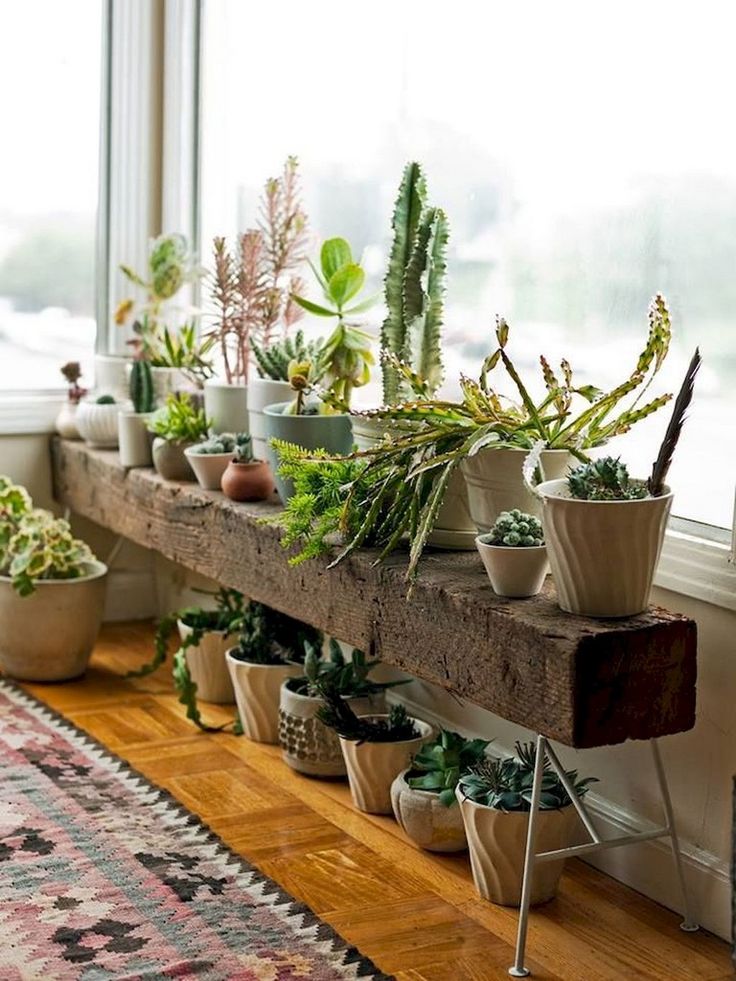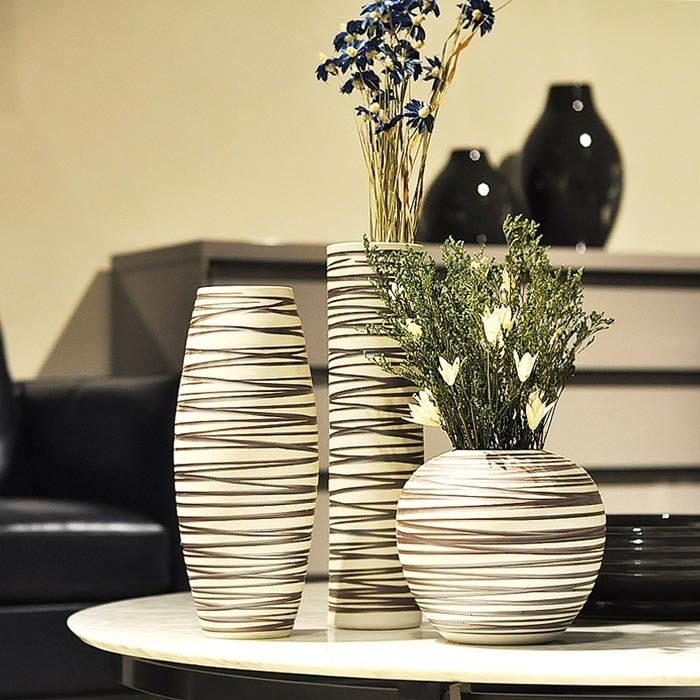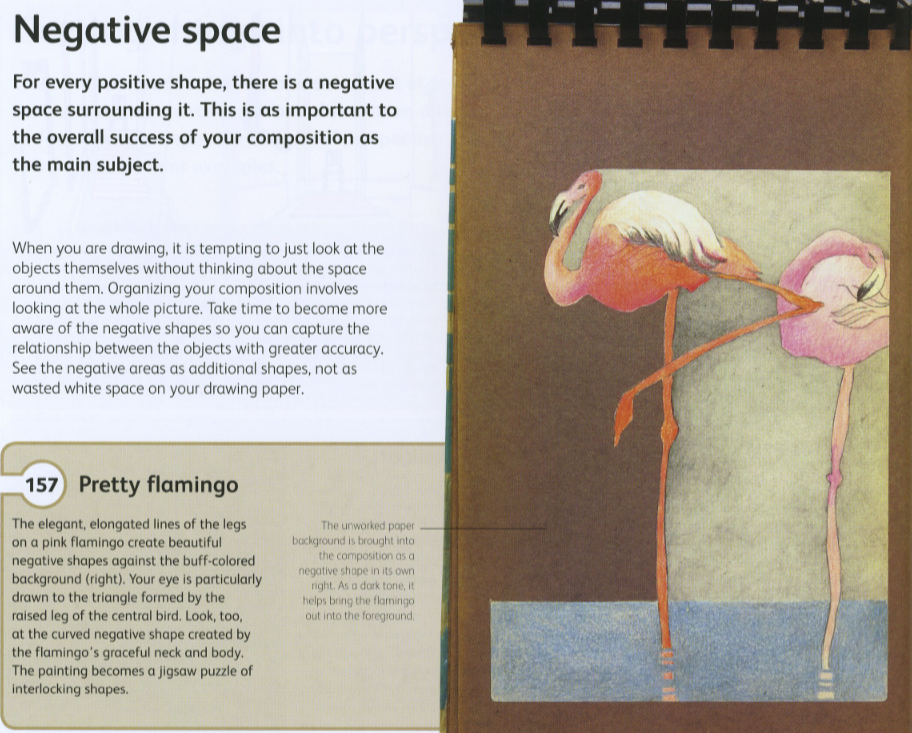Designing a new kitchen layout
7 Kitchen Layout Ideas That Work
You may have your cabinets, flooring, tile, appliances, and paint all selected. But what makes a kitchen livable has little to do with the way it looks, and everything to do with functionality.
Blog | Kitchen
Today’s post comes from the home improvement experts at Modernize.
If you’re planning a kitchen, there are a few essential kitchen layout ideas you need to keep in mind as you’re designing and planning.
Before you make any big decisions or get carried away with the aesthetic, here are 7 essential kitchen layout ideas you will want to incorporate to make your kitchen design a success:
1. Reduce Traffic
No matter what, the kitchen is probably going to be a high-traffic area of the house. But there are ways you can get around making the kitchen a catch-all for mail and backpacks and coats.
Create a space before you get into the kitchen, like a mudroom, to control the chaos that can come sweeping in every day. Once in the kitchen, make sure the primary pathway through the kitchen is hazard-free and will not be obstructed by the refrigerator or oven door when open.
2. Make the Distance between Main Fixtures Comfortable
When laying out your kitchen it’s important to keep the main tasks in mind – preparing, serving, and cleaning up from meals. You don’t want to put the stove across the room from the sink, or the fridge too far away from the stove because that will complicate whichever task you are working on.
Lay out kitchen fixtures and appliances within comfortable proximity to each other3. Make Sure the Kitchen Island Isn’t too Close or too Far
A kitchen island is where much of the meal preparation happens. If your kitchen layout will include one, consider its location carefully. Make sure that it will not block the area in front of your major appliances, such as wall ovens, dishwashers, and refrigerators.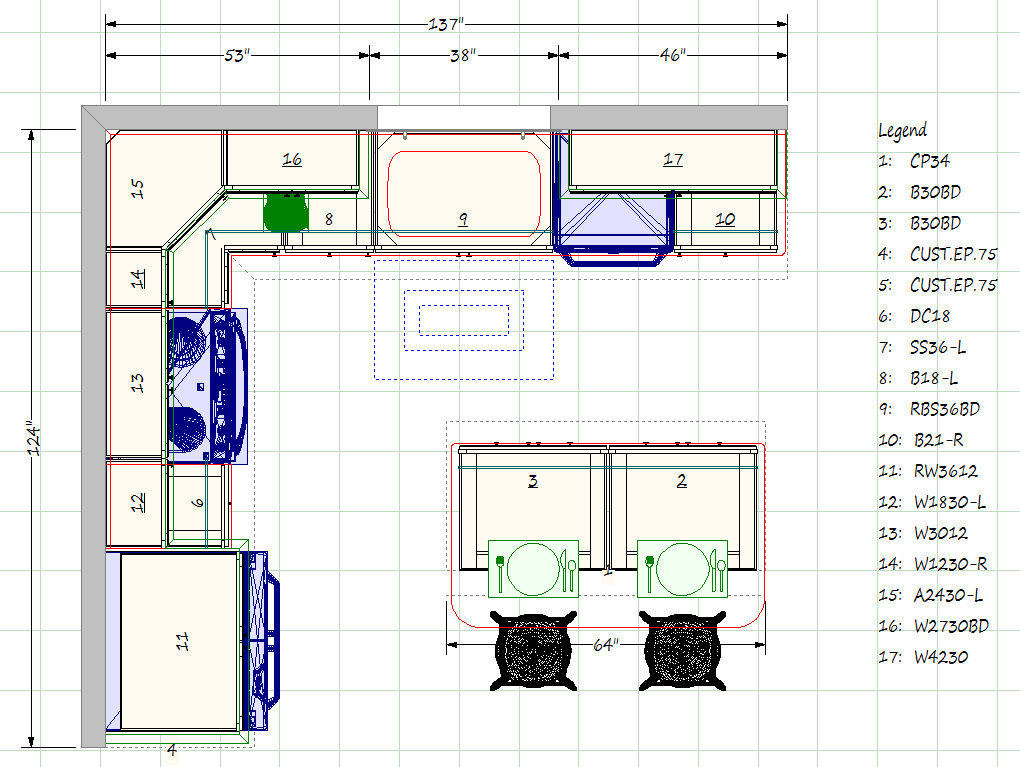
Allow enough space for the appliance door swing plus room to pass when the doors are open. But you also don’t want to place it too far. Make sure your island is located within a comfortable arm’s reach from each of these fixtures.
Keep appliance door swings in mind when placing an island in your kitchen layout4. Place the Sink First
When creating a kitchen layout, many designers place the sink first and then design from there. While this is probably grounded in tradition from the days when people spent a long time scrubbing dishes, it remains a good rule of thumb.
The oven and fridge are vital to preparing meals, but somehow the sink seems to still be the place where we spend the most time. Think about placing the sink where there is a view out a window or into the room. A kitchen island is also a great location for the sink.
Place your sink with a view into the room, out a window, or in a kitchen island for both5. Always Put the Stove on an Exterior Wall
When you’re deciding where to put the stove and oven, remember to put them on an exterior wall rather than an island or interior wall.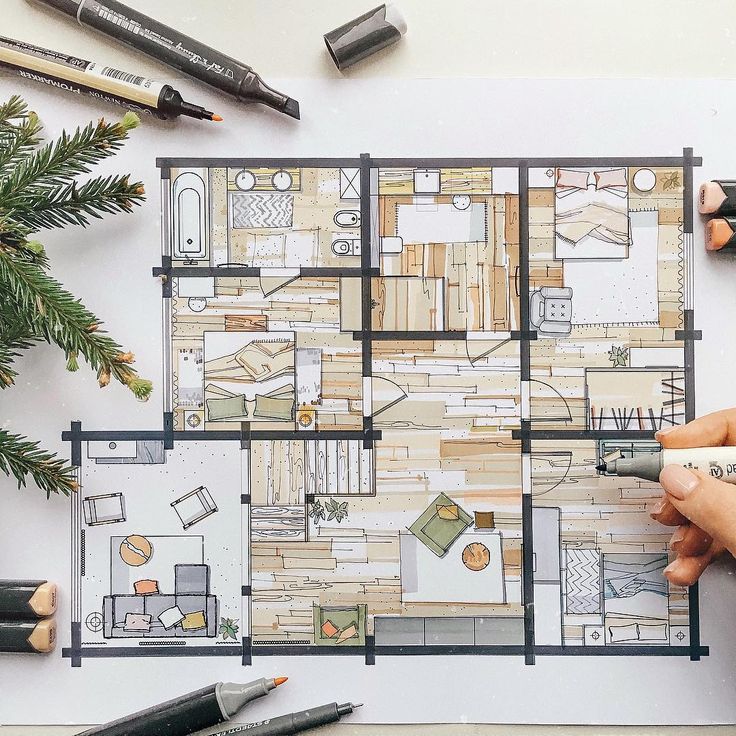 This will make it easier (and less expensive) to install a proper ventilation system.
This will make it easier (and less expensive) to install a proper ventilation system.
6. Keep Vertical Storage in Mind
Instead of focusing all of your energy on creating enough cabinet and drawer storage, put a little of that energy into configuring convenient wall storage.
Storage walls are a great way to incorporate pantry storage, small appliances, baking accessories, extra china, or even a broom closet – in one convenient location. Open shelves, wall hooks, and overhead pot racks are not only convenient – if stocked with the right stuff, they can also add dimension to the aesthetic.
Think Vertical – Combine storage walls, wall hooks, and open shelves for a mix of functional storage7. Create a Floor Plan and Visualize Your Kitchen in 3D
No matter how much designing, measuring, and pinning to your dream kitchen Pinterest boards you do, your completed kitchen can still come as a surprise once the contractors are finished – and not always in a good way.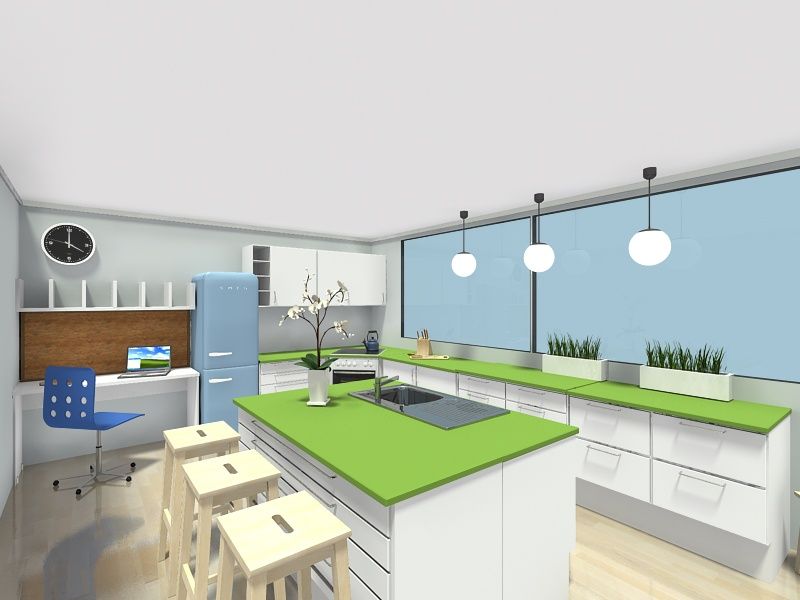
Save yourself from costly mistakes and unfixable flaws with a kitchen layout tool. RoomSketcher provides an easy-to-use online kitchen planner that you can use to plan your kitchen layout. Draw your kitchen floor plan, add fixtures, finishes, and cabinets, and see them instantly in 3D!
Visualize your kitchen layout ideas in 3D with a kitchen layout toolGet Started on Your Kitchen Design
Create 2D Floor Plans, 3D Floor Plans, and 3D Photos just like these, to share with your family, friends, or contractor for more accurate pricing.
Get Started
Don't forget to share this post!
Recommended Reads
28 ways to configure cabinetry |
When you purchase through links on our site, we may earn an affiliate commission. Here’s how it works.
(Image credit: Tom Howley )
Looking to remodel and need new kitchen layout ideas? This professional design advice will help you make the most of your kitchen floor space.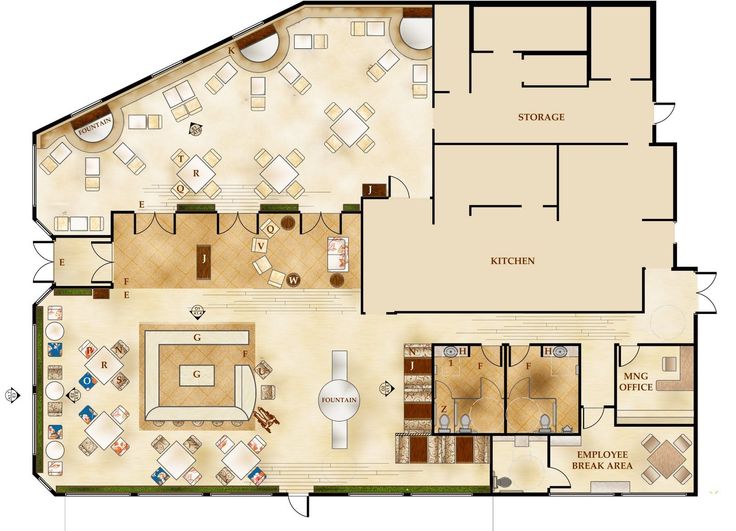
Kitchens come in all shapes and sizes, and you can be spoilt for choice with kitchen layouts and formation options when starting out on a project. The key is to take things slowly, and think carefully about how you use and move within the space.
Also consider how you see your family might use the room in the future. It may be all about food prep now. But down the line, it may need to double as place to finish homework, a 'teaching area' where your kids learn to bake, or a sophisticated entertaining spot.
Practicality is key for kitchen ideas when it comes to the best kitchen layout, and the shape you select should be able not only to accommodate your lifestyle, but enhance it. We've got plenty of food for thought, so go ahead and dive into our layout options.
Kitchen layout ideas
Our guide will explore all the key kitchen layout ideas, but first, clue yourself up on the six types of kitchen layouts that will likely form the base of your space...
What are the six types of kitchen layouts?
There are six key kitchen layouts:
- The galley layout
- The L-shaped layout
- The U-shaped layout
- The island layout
- The peninsula layout
- The one-wall kitchen
1.
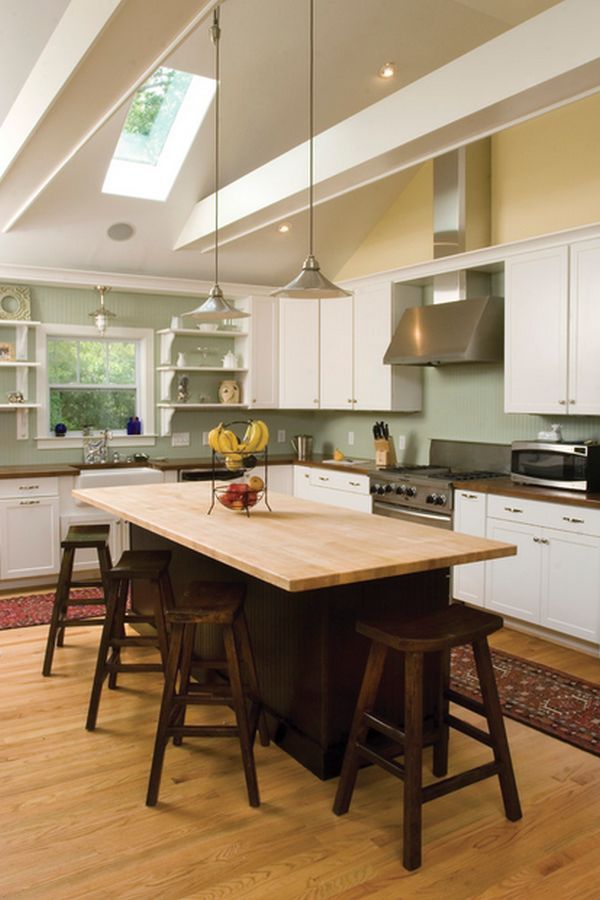 Let your habits dictate the layout
Let your habits dictate the layout(Image credit: Harvey Jones)
'Every aspect of the kitchen, how it works and how it is used is based around the layout,' says Sally Hinks, kitchen designer at Harvey Jones. 'When starting to plan a kitchen, the first thing you must think about is how you're going to be using the space, as this will dictate what you need to include. Is your kitchen purely for cooking or will you be entertaining, too?
'Will the space be used as a working from home spot or will the kids be doing their homework in there? It's also important to look at the existing features of the room. In many cases, doors, thoroughfares and windows set the parameters of the layout out and guide suitable options. Many people like to situate their kitchen to make the most of a lovely view outside or to take center-stage in an open plan space, which can be a useful starting point.'
2. Think: practicality
(Image credit: Benjamin Johnston Design)
'The main thing to keep in mind during the layout planning process is practicality,' says Sally Hinks.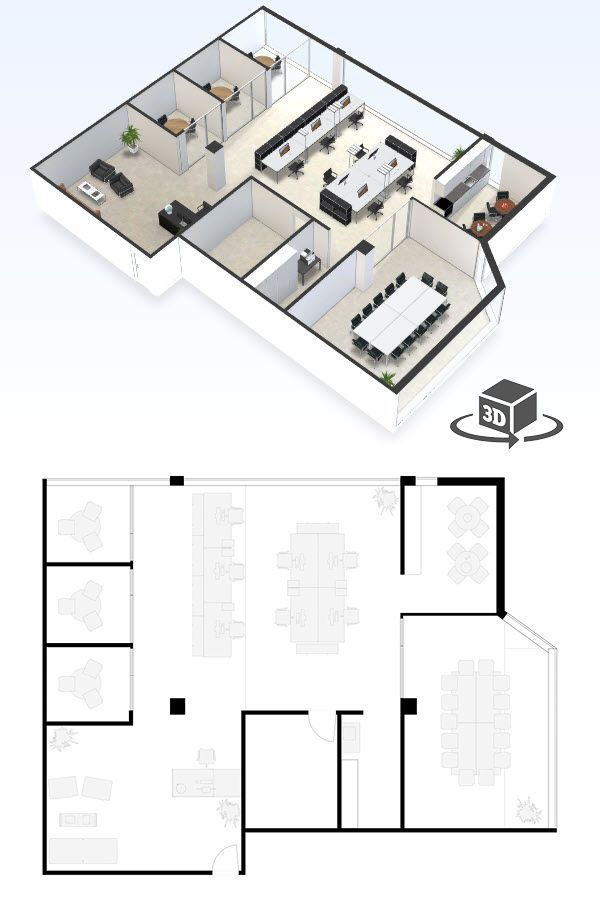 'Think carefully about which parts of the kitchen you're gong to be using the most from a cooking perspective and how easily you can move between them. Use the kitchen triangle method as a guide and focus on the refrigerator, sink and cooker as the core elements when mapping out your space.'
'Think carefully about which parts of the kitchen you're gong to be using the most from a cooking perspective and how easily you can move between them. Use the kitchen triangle method as a guide and focus on the refrigerator, sink and cooker as the core elements when mapping out your space.'
For more guidance, see our exploration that answers the question, where should a refrigerator be placed?
3. Use the galley layout for space efficiency
(Image credit: Future / Paul Raeside)
Galley kitchens are one of the most space-efficient layouts you can choose. They are ideal for keen cooks, and perfect for maximizing storage and work surface space in smaller kitchens. This super-efficient layout is ideal if you are looking for small kitchen ideas that maximize every inch of space.
Allison Lynch, of kitchen design company Roundhouse , says: 'A galley kitchen usually occupies a relatively small space – they are often a walkway between two rooms. An ideal length would be 3. 5 – 5m with space either side of the door opening to allow at least a standard depth countertop.
5 – 5m with space either side of the door opening to allow at least a standard depth countertop.
'Although they tend to be quite small, they are very ergonomic spaces with everything usually within arms' reach – with, ideally, the sink one side and the hob on the other.'
Placing these two important elements centrally within each run of units is the best approach, with the dishwasher on the sink side of the run and the refrigerator on the side of the hob.
4. Share your space with a U-shaped layout
(Image credit: Amanda Evans Interiors)
U-shaped kitchens are an ultra-practical option. They are comprised of countertops on three connecting sides, allowing plenty of room for cooking.
It's one of the most efficient layouts to have in both small and open plan homes alike, and the easiest way to achieve the ergonomic triangle that is so often talked about in kitchen design – where your fridge, cooker and sink are all within easy reach of one another.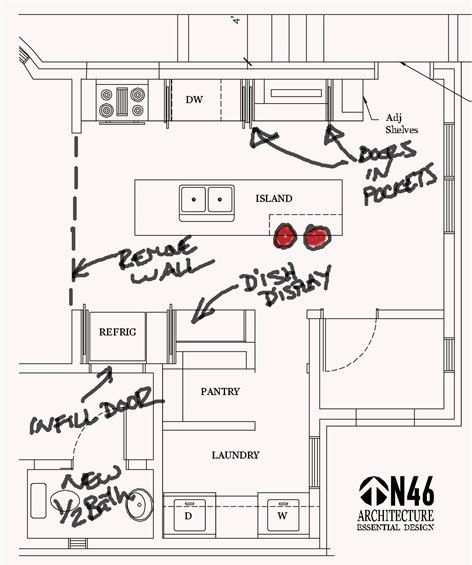
It also easily allows for two cooks in the kitchen at once for a team dinner-making effort.
Allison Lynch says: 'U-shaped kitchen ideas work best in spaces ideally from 3 – 3.5m, but remember that the bigger the space the more crossing the room you have to do.'
Larger kitchens can often accommodate the addition of a central island, too, like in this example by Amanda Evans Interiors . With plenty of room for cabinetry and built-in appliances around the edge, the island provides a casual seating area and additional preparation space.
5. Love your corners with an L-shaped layout
(Image credit: Davide Lovatti)
The most common layout is some sort of L-shape, with at least one straight run. The classic design uses two adjoining walls of a room to allow a continuous flow of worktops and cabinets.
The central area is kept free, so you can enjoy a spacious feel or add an island for extra worktop space and storage.
'L-shaped kitchens are a classic, timeless design,' say the team at Magnet.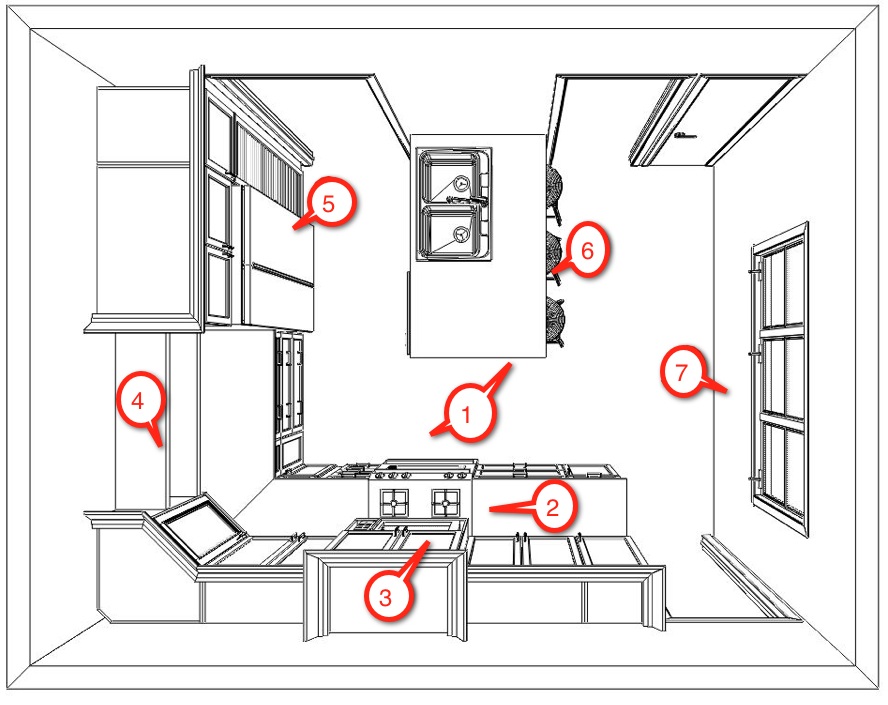 'And the open floor space it creates allows the kitchen to be accessible from any angle.'
'And the open floor space it creates allows the kitchen to be accessible from any angle.'
6. Create distinct zones with an island layout
(Image credit: Davide Lovatti)
Large kitchens and big families can really benefit from utilizing kitchen island ideas to add extra storage and preparation space.
Multi-use spaces are increasingly sought after, and an island can be used to prepare dinner while also keeping an eye on the kids, as well as doubling up as a socialising area, work space, or homework desk.
'The benefit of an island layout is that it is great for zoning in open plan areas, which is what most people opt for today,' says Roundhouse's Allison Lynch. 'It’s a good piece of social furniture and effectively creates two different spaces, one for cooking and one for prep, with one person at the island and the other at the worktop.
'Another big benefit in an open plan space is that an island can be made to look more like a piece of furniture.
'An island allows free movement all the way around, and people can enter the space from different directions. It can feel less monolithic, a much lighter piece of furniture than a peninsula, and with judicious use of plinth lighting it can be made to look like it is floating.'
7. Use a peninsula to disrupt a thoroughfare
(Image credit: Future / Manolo Yllera)
A kitchen island is wonderful, but if it will create a natural passage through the cooking space from one area to another, such as from the hallway through the kitchen into a garden, kitchen peninsula ideas may be a better choice.
'Consider alternatives to a kitchen island, even if you have space,' advises Homes & Gardens' associate editor Busola Evans. 'A peninsula, for instance, can provide many of the benefits of an island without interrupting the cooking workflow.
8. Choose an L-shaped layout for a party kitchen
(Image credit: Marlaina Teich Designs/Patrick Cline)
If your kitchen tends to be the life and soul of the party, choose a layout that will accommodate abundant entertaining. The open nature of an L-shaped kitchen means lots of space for guests to gather in the opposite side of the kitchen to where the units are based.
The open nature of an L-shaped kitchen means lots of space for guests to gather in the opposite side of the kitchen to where the units are based.
As demonstrated in this home with interior design by Marlaina Teich , it is also a great choice for kitchen diner ideas, and open plan spaces that merge into a living area. This kitchen boasts a dining area off one side and a living room off another – the L-shaped layout keeps the kitchen neatly tucked in one corner, while the added island provides connection to the other spaces.
9. Consider appliances early in your layout plans
(Image credit: Harvey Jones)
'Another factor that will affect your kitchen layout is the type of appliances and tall cabinetry you want to incorporate,' says kitchen designer Sally Hinks. Tall cabinetry and appliances look strongest standing alone or on the end of a cabinet run, so this can dictate potential layouts during the initial stage.'
10. Make the most of a small space
(Image credit: Harvey Jones)
'When designing small kitchen layouts, choose your appliances wisely,' says kitchen designer Sally Hinks.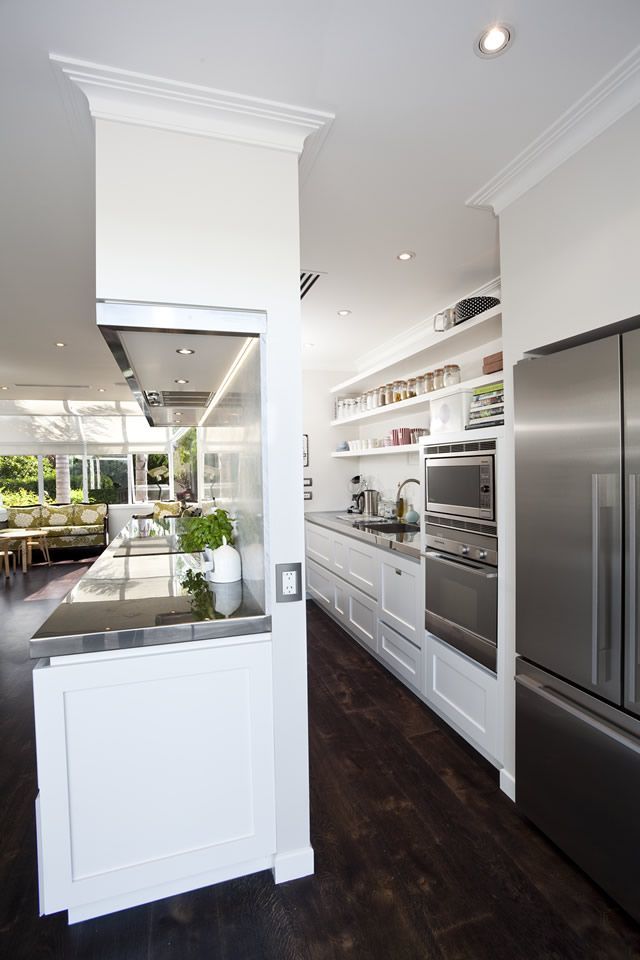 'Any large appliances such as washer dryers that can multi-task are worth considering. Furthermore, integrating appliances wherever possible will open up the space visually and create cleaner lines. Smaller appliances such as coffee makers and microwaves can be housed in cabinets to free up valuable countertop space, keep surfaces clear from bulky devices and create a more minimal aesthetic.'
'Any large appliances such as washer dryers that can multi-task are worth considering. Furthermore, integrating appliances wherever possible will open up the space visually and create cleaner lines. Smaller appliances such as coffee makers and microwaves can be housed in cabinets to free up valuable countertop space, keep surfaces clear from bulky devices and create a more minimal aesthetic.'
11. Make the most of natural light in small kitchens
(Image credit: Emily J Followill/Beth Webb Interiors)
Galley kitchen styles may be great for small spaces and ergonomically sound for keen cooks, but they can have a reputation for being a little dark and pokey. To counter this predicament, be sure to make the most of any natural light coming into the space when planning a kitchen.
In this example with interiors by Beth Webb , a window at the short end of the galley has been extended to stretch from floor to ceiling. The window on the right hand side is free from the constraints of upper level cupboards, meaning that light can travel freely into the rest of the kitchen.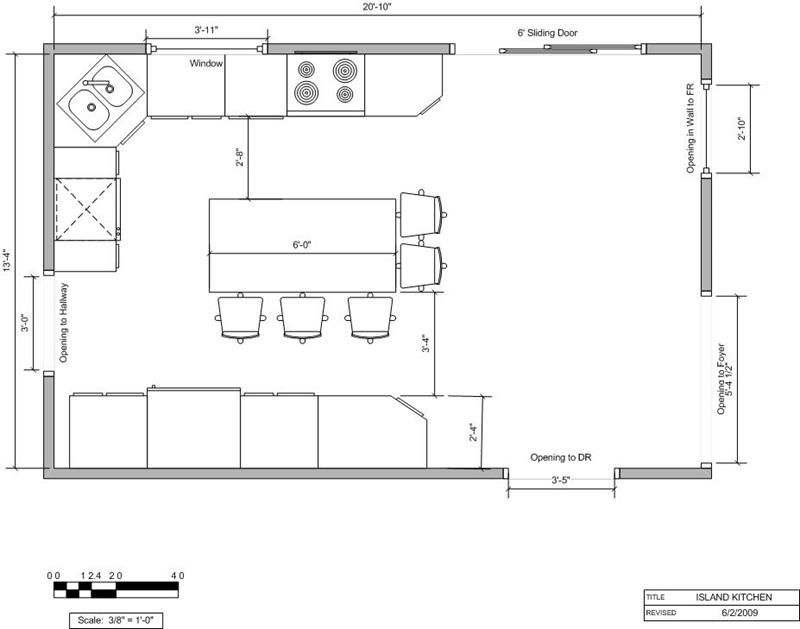
12. Create a ‘Chef’s Table’ experience with a long island
(Image credit: Richard Felix-Ashman Design/Aaron Leitz)
For serious foodies, cooking and serving dinner is the main event, especially when entertaining guests with equally strong culinary inclinations. Upgrade your island’s seating area from a casual breakfast bar to a full-blown dining area, by choosing a larger-than-life island that can accommodate a dinner party.
Bringing guests into the kitchen space can help create a unique ‘Chef’s Table’ experience, as demonstrated in this stunning kitchen in a bar conversion by Richard Felix-Ashman . A large kitchen for entertaining, it also hosts two dining tables for when you want to give a more intimate feeling to a gathering.
13. Bring personality to an open-plan space
(Image credit: Future/Polly Eltes)
'Open-plan kitchens can easily feel disjointed if the different areas aren't carefully linked,' explains kitchen designer Sally Hinks.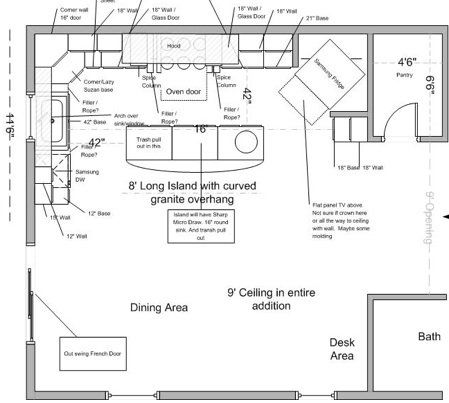 'Kitchen islands and peninsulas are a good choice to bring the kitchen out into the room, while accommodating seating areas within an island is a great way of tying dining areas and kitchen spaces together.'
'Kitchen islands and peninsulas are a good choice to bring the kitchen out into the room, while accommodating seating areas within an island is a great way of tying dining areas and kitchen spaces together.'
14. Keep kitchen layouts simple to enhance space
(Image credit: Ginny Macdonald/Sara Tramp)
'Using light kitchen color ideas and mirrored backsplashes will open up spaces,' says Allison Lynch. 'Keep things simple. In galley kitchens in particular, keep tall cupboards for dry food storage and the fridge to the ends of the room, and perhaps limited to one side but not both.
'Too many details will crowd the space – keep to simple clean lines and lose the clutter.'
15. Pick storage that's truly ergonomic
(Image credit: Neptune)
Never underestimate the importance of good kitchen storage ideas. Nerine Vacher, kitchen designer at Neptune Fulham in London, advises: 'Effective storage is one of the simplest ways to create a happy and homely kitchen.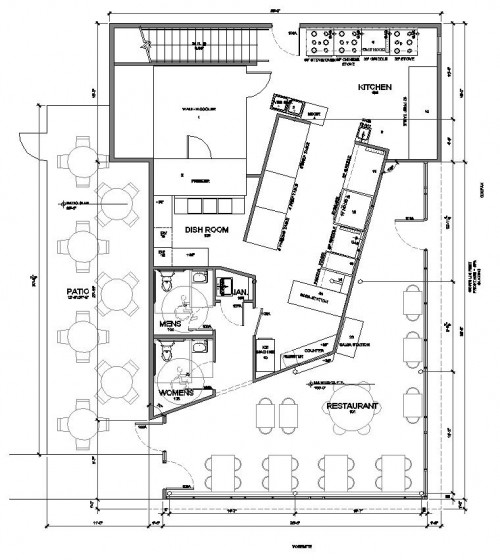
'By including a single piece of furniture, like our Suffolk larder (above), a bi-fold cabinet, or even an island, you can completely transform your kitchen, by creating more surface space and keeping clutter out of sight.'
H&G's Busola Evans adds: 'Ensure your bottom units are drawers rather than cabinets. Deep drawers are a more efficient use of space and give easier access to items at the back.'
16. Consider the second work triangle, too
(Image credit: Rikki Snyder)
'I've moved house seven times – and designed seven new kitchens for myself,' says H&G's Editor in Chief Lucy Searle. 'Plus, I've interviewed countless kitchen designers over the years, both for my kitchen remodels, and professionally.
'In time, I've realised that there's a second kitchen work triangle that no one talks about overtly – but it's really important.
'The second kitchen work triangle is between the kitchen sink, the bin(s) and the dishwasher.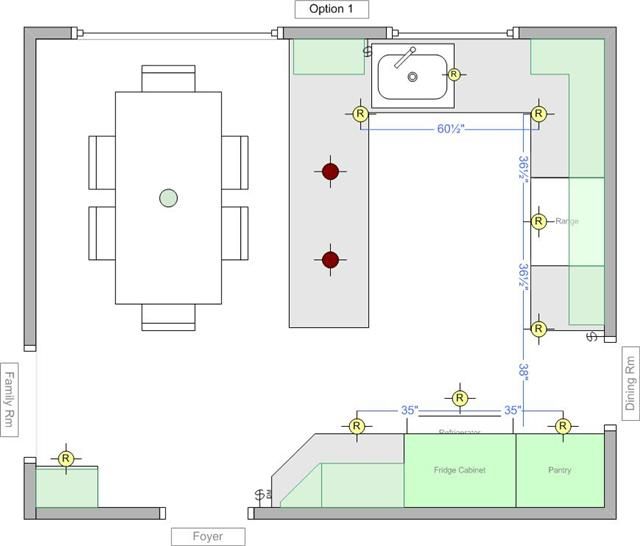 These three elements need to be as close to one another as possible to make tidying up after dinner as easy as possible. You want to scrape plates, rinse them and stack them all in one easy move, without pacing up and down the length of the kitchen.
These three elements need to be as close to one another as possible to make tidying up after dinner as easy as possible. You want to scrape plates, rinse them and stack them all in one easy move, without pacing up and down the length of the kitchen.
'If you can ensure that the dining area is towards that end of the kitchen when planning its layout, too, you'll find it makes life even easier.'
17. Work out storage zones
(Image credit: Martin Moore)
When planning your kitchen layout, one key aspect is to consider how you want to use the kitchen and where you want items to be stored.
Naturally, heavy pots and pans should be kept in lower cabinets, and within easy reach of your oven and hob.
Likewise, mugs should never be too far away from your kettle. In this open plan kitchen, the dining table is in the same space as the kitchen area, so the addition of a tall dresser provides storage for crockery and cutlery, to make laying the table quick and easy.
18. Put in a pantry
(Image credit: Sustainable Kitchens)
Larder or pantry ideas separated from the rest of your kitchen can help keep things clear and tidy, as they are an ideal space to keep store cupboard staples and baking equipment.
In this barn conversion project, the ceilings were low and natural light was limited, so a walk-in pantry was designed by Sustainable Kitchens . It has internal windows and under-counter cabinets only, so that it feels bright and connected to the rest of the kitchen. Automatic lighting makes it extra bright inside.
19. Maximize storage and workspace
(Image credit: Burbridge Kitchens)
Most L-shaped kitchens are fitted onto adjacent walls of a room, creating a practical corner design. They provide plenty of work surface as well as storage, though be mindful of where the two runs of cabinetry meet – the addition of pull-out drawers or an internal carousel will help to avoid wasting useful storage space.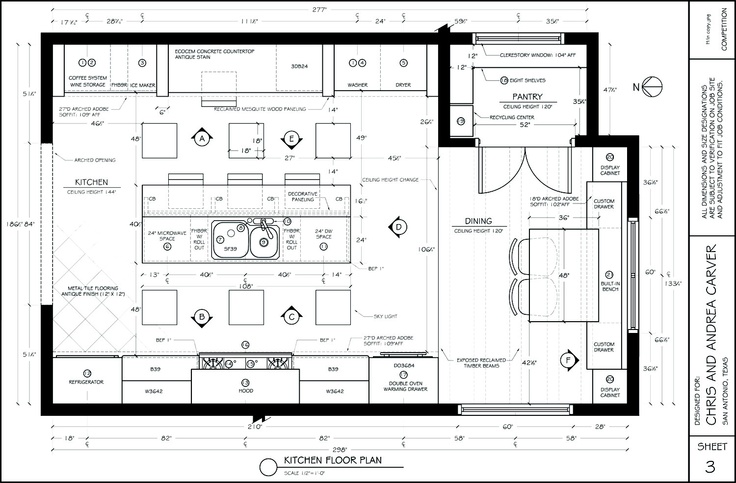
Consider keeping wall cabinets to one side of an L-shaped layout, opting for open shelving on the other so as not to make the room feel overcrowded. If space allows, you could add a dining table.
20. Use your alcoves
(Image credit: Tom Howley)
You are likely to inherit some unusual nooks in older country properties, so taking a flexible approach to your kitchen design may be necessary.
Look for alcoves and recesses that you can build storage into and toss out the idea of a conventional fixed layout. Add single runs of cabinetry wherever they fit best in the space you have to work with, incorporating your appliances in between.
To add to this flexible approach, go for a portable kitchen island or freestanding island design – units on legs open up the amount of floor space on show and can be moved around if needed, too.
21. Build banquette seating
(Image credit: Martin Moore )
Banquette seating ideas mean you can fit more seating into the available space when it is built in to the design of your kitchen.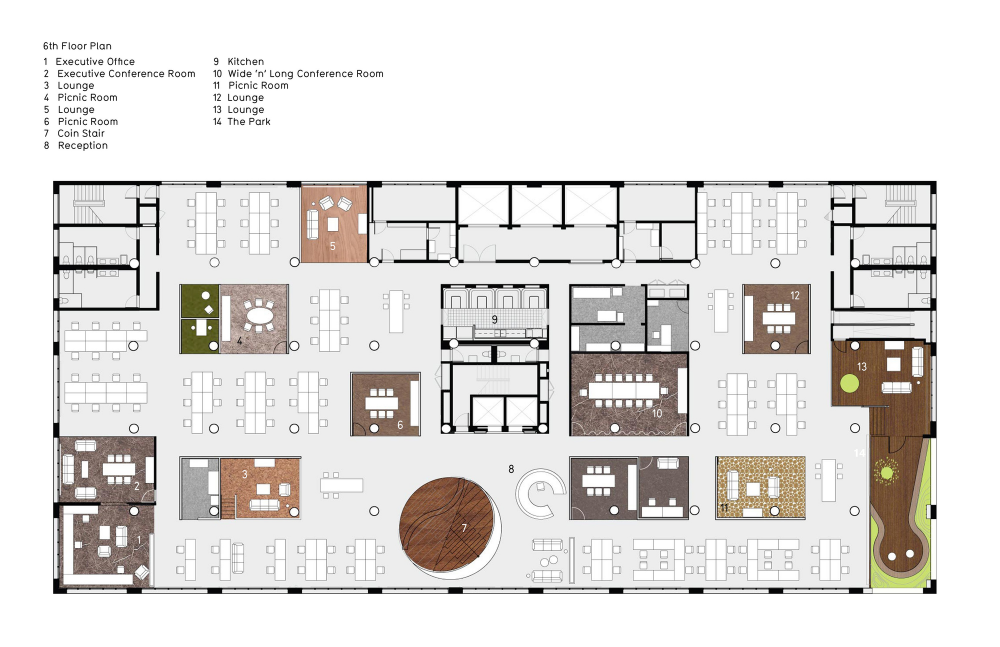
The fitted, upholstered benches not only provide storage beneath, but are a clever way to hide any unsightly wires or pipework. ‘These are a necessary evil that may have to be boxed in to be concealed,’ says Daniela Condo, designer at Life Kitchens . ‘See if services can be re-routed inside bulkheads, voids or under the plinth of the kitchen.’
22. Enjoy layout flexibility with freestanding furniture
(Image credit: Sebastian Cox X deVOL)
Often found in rustic-style homes, free-standing furniture offers a more flexible approach to kitchen design. It’s a relaxed look, enabling you to add single runs of cabinets around the kitchen to create your ideal layout, incorporating your appliances in between.
This mix-and-match method works particularly well in older, country-style properties where the room may be unusually shaped. Paired with complementary wall-hung cabinets, a run of wooden free-standing cabinets will provide ample storage for small kitchens, as seen in this example by deVOL .
(Image credit: Harvey Jones)
A kitchen-diner layout is ideal for busy family households, where both the cooking and dining zones sit within the same design.
‘When planning a kitchen, take inspiration from the existing features in the room, such as doors, thoroughfares and windows,’ says Sally Hinks, kitchen designer at Harvey Jones. ‘Looking at these elements will help you site the table in the best possible position.’
24. Go with the flow
(Image credit: Naked Kitchens)
‘Always walk through the plan in your mind to ensure it flows well and works efficiently, making sure that you can easily and fully access appliances so there are no pinch points,’ says Jayne Everett, creative director of Naked Kitchens .
‘If you go for an island, make sure there’s enough space around it to pass through and open cabinets,’ she adds. It’s the well-planned, seamless flow around the U-shaped layout and the double-ended island that makes this kitchen design work well.
25. Make the most of a large kitchen
(Image credit: Magnet)
It’s easy to be spoilt for choice when considering kitchen layout ideas for a large area, but don’t overlook one of the most popular layouts, the U-shape, which can be the perfect match for a generously sized kitchen.
To suit the open space, this particular layout is comprised of worktops on three connecting sides to allow for ample room for cooking. This design – by Magnet – is created for high efficiency cooking and accommodates the ‘working triangle’ perfectly, meaning you can easily move between the three key cooking components, sink, oven and refrigerator.
This kitchen layout encourages smooth food preparation, plenty of practical storage space and allows two chefs to be operating at once, making mealtimes a real team effort. It also incorporates a peninsula breakfast bar idea, so visitors aren't excluded from the action.
26. Include an island in a different color
(Image credit: LochAnna Kitchens)
With open plan living proving increasingly popular, islands today come in a range of styles, functions and sizes to suit your space.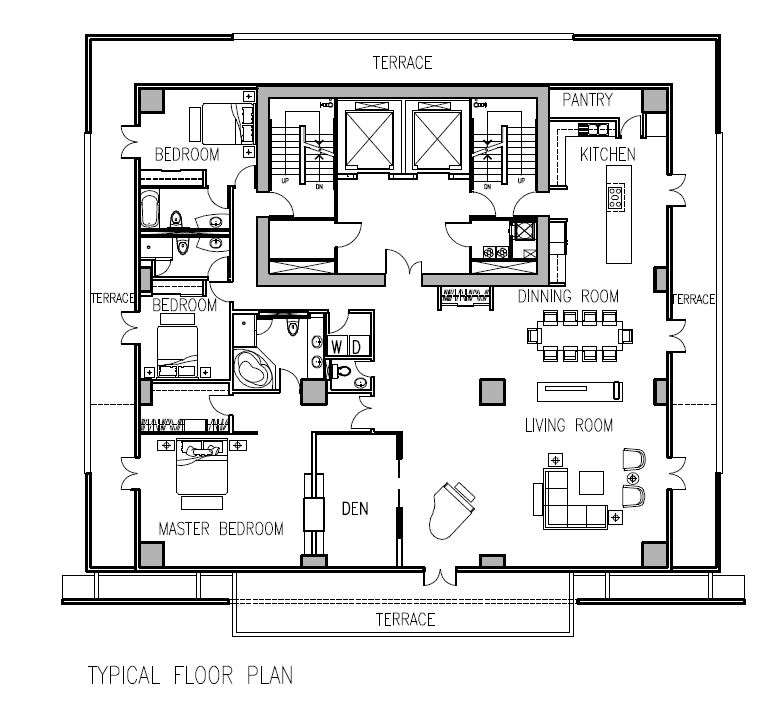 Offering the possibility of extra room for
both cooking and seating, they can help turn a kitchen into the hub of the home.
Offering the possibility of extra room for
both cooking and seating, they can help turn a kitchen into the hub of the home.
To make an island the focal point, choose one in a different color from the rest of your cabinetry, as shown in this traditional kitchen design that combines earthy brown and off-white.
The length of this island allows a variety of different elements to be included, including a sink and ample storage.
27. Create the heart of a family kitchen
(Image credit: Future plc / Darren Chung)
To tie a family kitchen together, the addition of an island can be the final piece to the puzzle. Usually suited to medium-to-large sized kitchen layout ideas, an island can contribute valuable extra storage and worktop space that’s so sought after by large families.
When prepping meals at the island, parents can keep one eye on dinner and one on the kids, too. Then in the evenings it can transform into a dining table or even an office and homework club, offering the family a place to catch up and congregate, like the multi-purpose island in this stylish grey kitchen.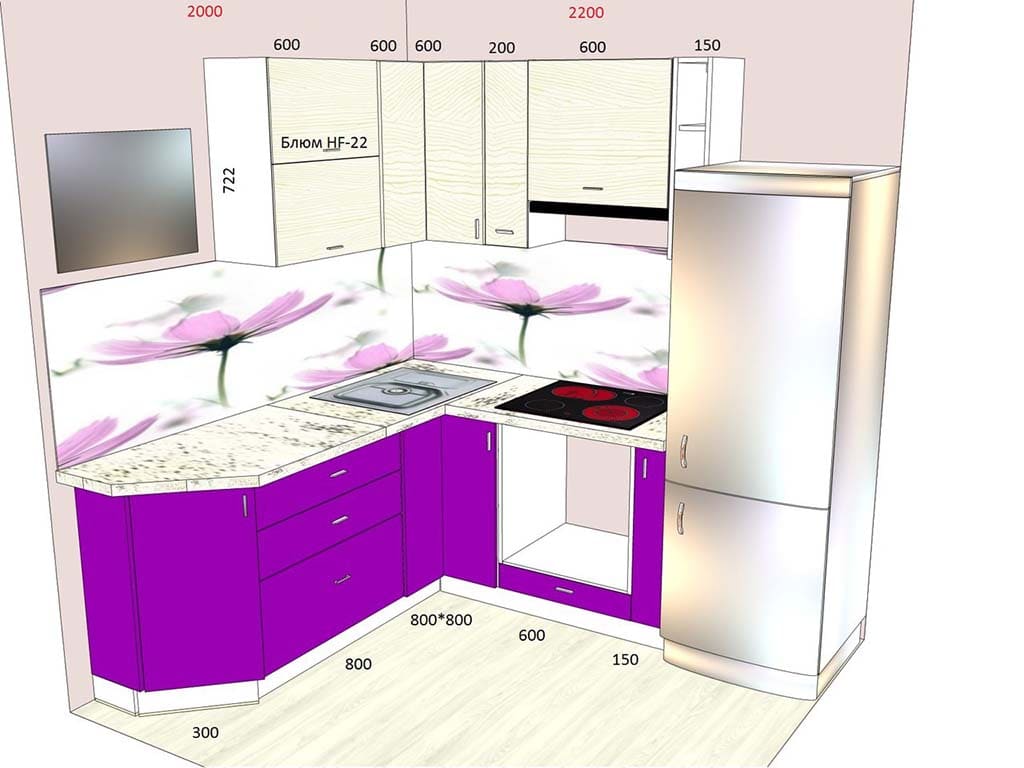
(Image credit: Future)
If your U-shape is more generous, it's worth sticking to the work triangle principle as closely as possible, but ensuring the three important elements are grouped on just two sides of the kitchen, with the third side given over to kitchen storage.
'If your kitchen's third side is an island, like the one above, storing cutlery, plates, china – in fact any items use use for dining – is the best option,' advises Homes and Gardens' Editor in Chief Lucy Searle.
'If you are keen, unflappable cooks who like to entertain regularly, having the hob on that unit with the cookware you need below will also work brilliantly – and be much more sociable.'
To avoid any costly kitchen design mistakes, the first step is to think carefully about how you move within the space and how you see your family using the room in the future – and this is where the well-known kitchen work triangle comes into play.
'The "work triangle" is the common sense principle that a kitchen plan revolves around the location of the sink, cooker and fridge and that the kitchen plan should be based on the most efficient workflow using these elements,' says Adrian Bergman, senior designer at British Standard by Plain English .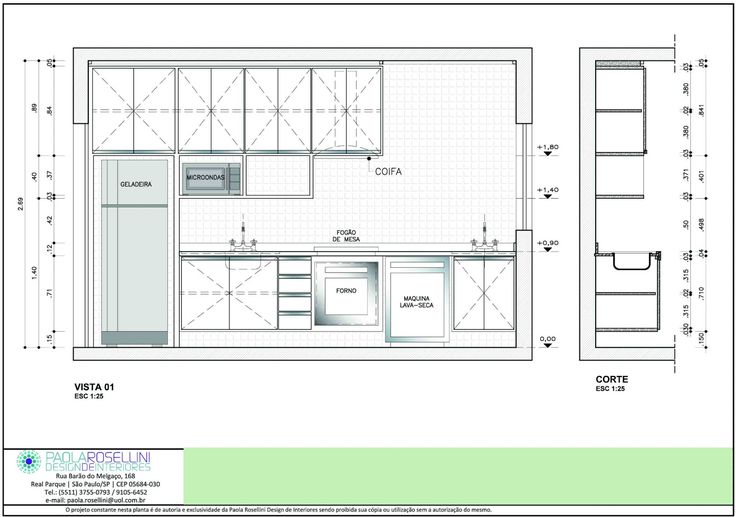
'This is, of course true, especially in a busy kitchen, but there can be other considerations such as aesthetics and respect for the architecture of a room, so there are occasions where we might stretch the layout rules to achieve a result that pleases the eye as well as the brain.'
Adrian continues: 'Usually, the size and shape of the room will suggest the best kitchen layout ideas, but often there is a choice and there are pros and cons to each; a single long run, for example, can look smart but means a lot of walking between elements and the fact that guests will be looking at the chef's back while they cook.
'I find that the best approach is to mock up and test any kitchen layout ideas in the actual space using battens and trestles, or with blocks of paper on the floor to represent the cupboards and appliances.'
Ailis started out at British GQ, where a month of work experience turned into 18 months of working on all sorts of projects, writing about everything from motorsport to interiors, and helping to put together the GQ Food & Drink Awards. She then spent three years at the London Evening Standard, covering restaurants and bars. After a period of freelancing, writing about food, drink and homes for publications including Conde Nast Traveller, Luxury London and Departures, she started at Homes & Gardens as a Digital Writer, allowing her to fully indulge her love of good interior design. She is now a fully fledged food PR but still writes for Homes & Gardens as a contributing editor.
She then spent three years at the London Evening Standard, covering restaurants and bars. After a period of freelancing, writing about food, drink and homes for publications including Conde Nast Traveller, Luxury London and Departures, she started at Homes & Gardens as a Digital Writer, allowing her to fully indulge her love of good interior design. She is now a fully fledged food PR but still writes for Homes & Gardens as a contributing editor.
How to make a kitchen project yourself?
Every housewife knows which kitchen will be ideal for her. Where she will store cutlery and where the microwave will fit perfectly. And it would seem, what is easier - to draw up a project for a new kitchen!?
Anyone who has already thought about buying a kitchen knows that one of the most important and difficult tasks when choosing a kitchen is the creation of a project.
Rits kitchen designers will make a free design project for you, take into account all the features of the room and your wishes in the choice of materials, accessories, colors and location.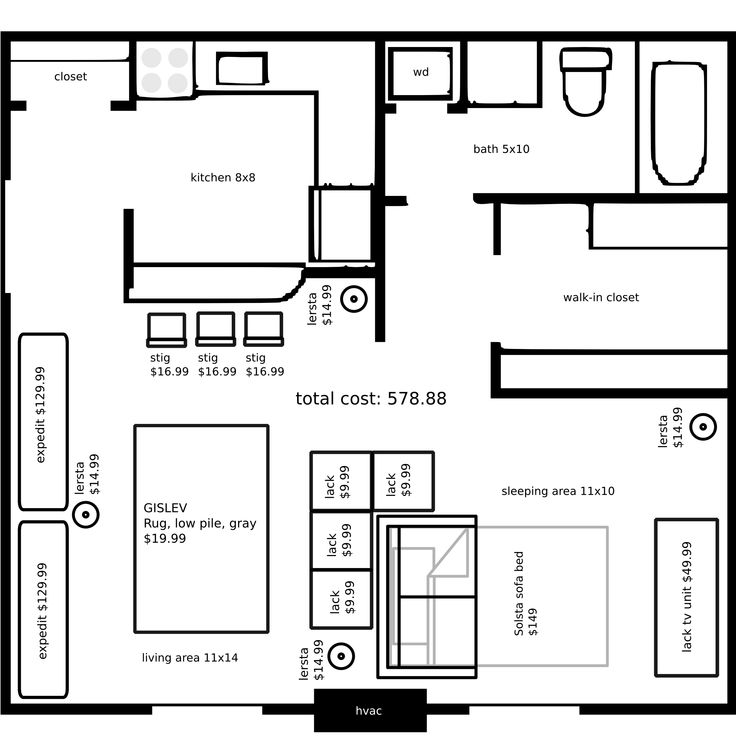
Call now and we will advise you on all issues. Tel.: 8(8332) 37-56-60.
For those who want to experience "from and to" all the delights of purchasing a kitchen set, we will tell you how you can design the kitchen of your dreams on your own.
Kitchen planning can be divided into 5 steps. Let's analyze each separately.
Creating your own kitchen project.
Stage 1: measuring the kitchen area.
Before making a drawing, let's arm ourselves with a piece of paper, a pencil and a tape measure, with which we will make measurements of the kitchen .
On the sheet it is necessary to indicate all the dimensions of the room : the length and width of the walls, the height of the ceilings.
For a more accurate project, it is necessary to note the location of windows, doors, ventilation. We will definitely put the results obtained on the sketch, this will help not to miscalculate the dimensions of furniture and appliances.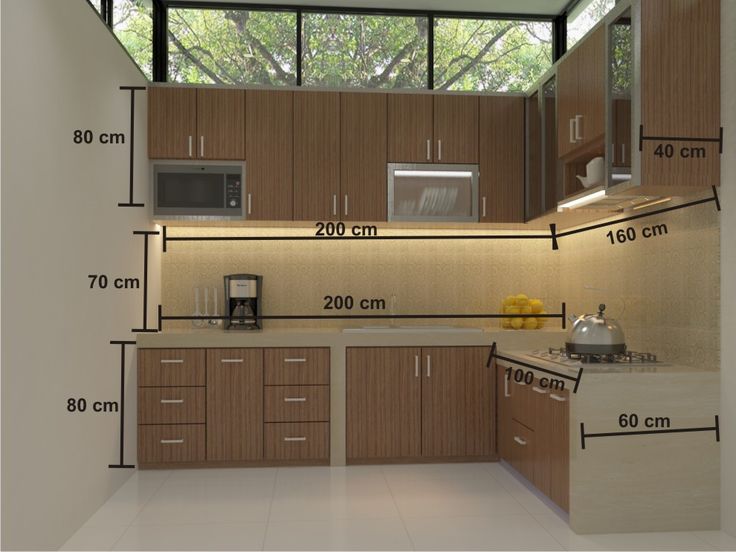
Step 2: Determine the working area.
Before planning the location of the cabinets in the kitchen, must be determined on the sketch of the area of the working triangle of the kitchen . The essence of the work triangle is to combine the main elements of the kitchen - a refrigerator, a stove, a sink and a place for cutting food into work areas.
Cooking area, washing area and storage area are the main "pillars" on which a competent approach to organizing space in the kitchen is built.
Proper design will save the hostess time and effort.
Attention: Do not place the sink far from the drain, and the stove - from the gas pipe and the exhaust outlet! Set the refrigerator away from a warm place (radiator or oven).
Step 3: Kitchen layout selection.
At this stage, you need to decide on the option for your kitchen.
What are they?
- Linear layout is suitable for a small space.
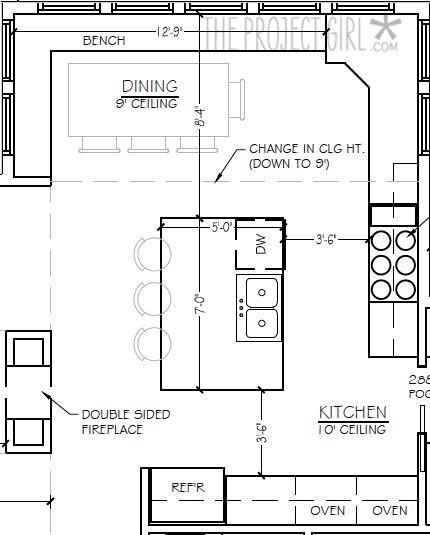 With this layout, furniture and household appliances are placed along one wall.
With this layout, furniture and household appliances are placed along one wall. - Parallel layout would be appropriate for a spacious kitchen. Furniture is placed parallel along two walls.
- L-shaped layout will fit in any kitchen. This ergonomic option ensures the convenience of using the refrigerator, stove and sink (triangle rule).
- For a large kitchen, an interesting solution would be U-shaped layout. It involves placing the headset along three adjacent walls, and in the center - a dining table. But even if the area of \u200b\u200bthe room allows you to place a large number of cabinets and shelves, this layout is only suitable for a large family.
- Layout with island in the kitchen is a spectacular and stylish option that requires enough space. With this layout, it is worth remembering that the distance between the island and the rest of the furniture should be at least one meter on each side.
Please note that the kitchen needs space for a dining area .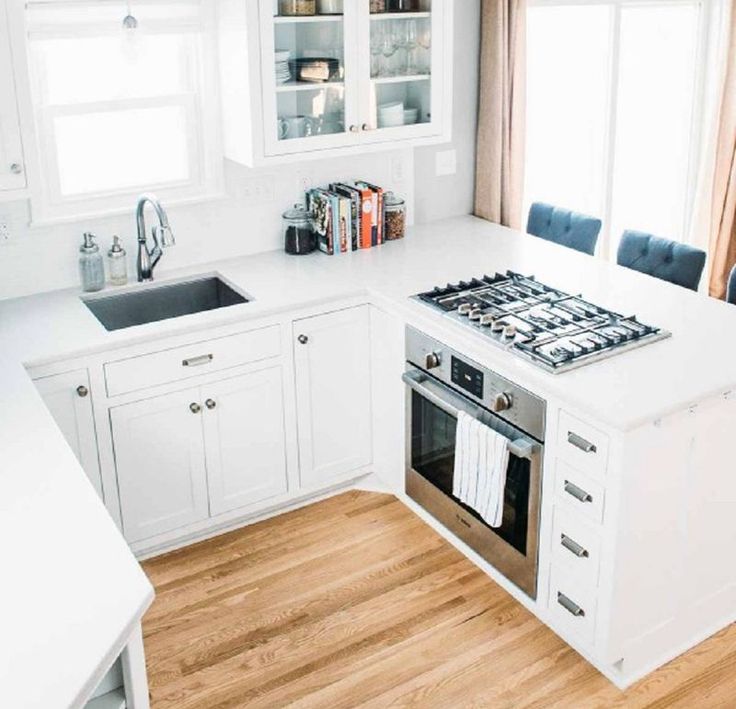
What it will be - a table with chairs, a corner or a bar depends on the size of the kitchen, the number of households and the preferences of the family.
Step 4: Sketching.
In this step we combine all our preferences on the sketch. We start with the arrangement of large-sized elements - sinks, refrigerators, stoves. If it is necessary to place a washing machine or dishwasher, then we determine the place for them. And then we distribute free space for kitchen cabinets.
View a variety of ready-made kitchen designs, drawn by hand or with the help of special programs.
Try sketching yourself. To facilitate this task, you can use the kitchen design sheet.
- Place the sink, dishwasher and washing machine close to the water pipes;
- The distance from the stove (or hob with oven) to the gas pipe is no more than 3 meters. Otherwise, you will have to use flexible eyeliners;
- Stove, sink and refrigerator are the vertices of the working triangle.
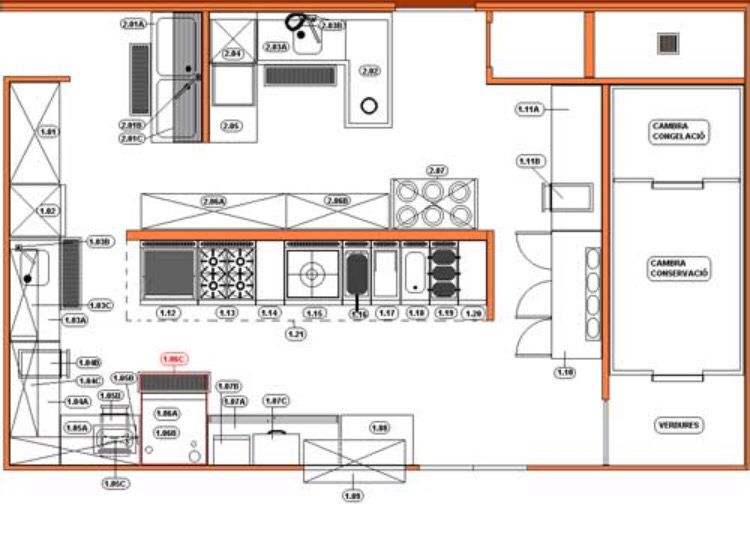 Keep this in mind when designing your project. The optimal distance between them is 1.5-2 meters;
Keep this in mind when designing your project. The optimal distance between them is 1.5-2 meters; - The battery, stove and sunlight will adversely affect the operation of the refrigerator, so do not allow direct contact between them;
- Plan the location of outlets and extension cords in advance so that each appliance can be easily connected to the mains.
- Don't forget the hood. It is necessary for cooking and, in addition, will decorate the interior.
- Please note that it is advisable to place the dish dryer in the immediate vicinity of the sink.
- Consider how the doors open: conventional (left-right) or more modern (up-down).
Step 5: choose the texture, color and style of kitchen furniture.
After working on the sketch, you can think about the choice of materials - facades, countertops, dining group, which should harmoniously fit into the interior of your kitchen, meet the standards governing quality, your financial preferences.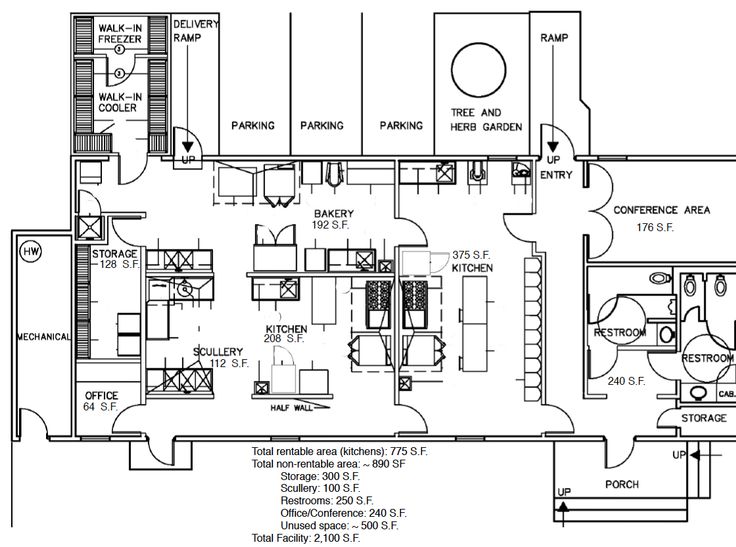 And there are no restrictions here.
And there are no restrictions here.
Kitchen in the apartment: layouts and configurations: how to choose, tips and hints
| The kitchen and its ergonomics raise many questions. What are the types of kitchen layouts? What layout can be considered ideal - a square room or a rectangular one? How to arrange kitchen interior items in rooms with different layouts? How does the size of the place affect the configuration of the kitchens? Which kitchen is suitable for non-standard layouts? We will talk about all this in this article. | Contents
|
General laws of kitchen ergonomics
Every kitchen is different because everyone's needs and habits are different. Everyone equips her room as it is convenient for him. But still, there are some interior design rules for a modern kitchen that make it comfortable for most people, regardless of the type of layout.
Everyone equips her room as it is convenient for him. But still, there are some interior design rules for a modern kitchen that make it comfortable for most people, regardless of the type of layout.
Kitchen area and its zoning
How to get from the fridge with a heavy borscht pot or from the cutting board to the stove without getting tired? We cannot completely eliminate fatigue during daily kitchen chores, but there is a way that helps to minimize physical exertion and speed up the cooking process.
Correctly zoning the room will help the rule of the "working triangle". With it, the kitchen will become much more convenient. Scientists have proven that it cuts the time spent cooking, almost grating and moving around the kitchen by half.
The corners of the "working triangle" are the main areas of the kitchen. These are the places that are involved in every preparation of dishes - storage (refrigerator), preparation (washing), cooking (stove). Imagine the size of your two or three steps - this is the optimal length of the side of the triangle.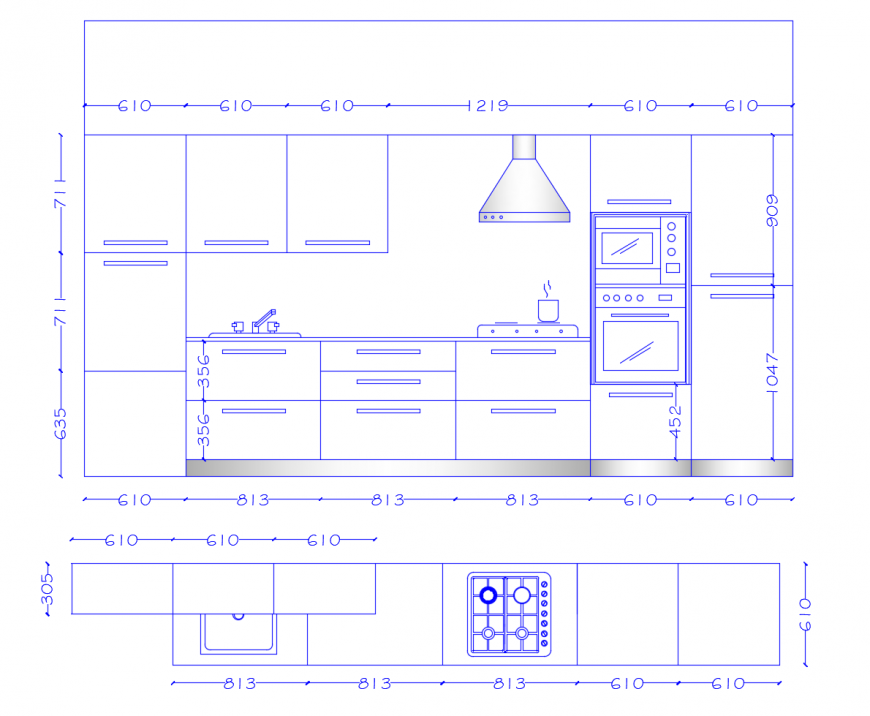
IMPORTANT! Everyone has their own places of main activity. Maybe you run into the kitchen just to heat up a pizza? Or is the kitchen your permanent residence? Track the sequence of the process. “I got it, washed it, cooked it, put it away” or “I took it out, warmed it up, ate it, put it away,” for example.
When planning your interior design, think about this. Everyone has their own idea of the perfect interior. Sometimes the design of our dream kitchen is contrary to the rules and laws of rationality. But when dreams come true, sometimes it doesn't matter how long it takes to walk from the refrigerator to the sink.
How to properly place appliances in the interior of the kitchen?
Today, kitchen design cannot be imagined without technology. Kitchen appliances change size, they become larger, and there is experience that tells you where it is most convenient to place them.
- Microwave.
Not so long ago, the place for a microwave in the interiors of many was a part of the countertop near the stove or a refrigerator.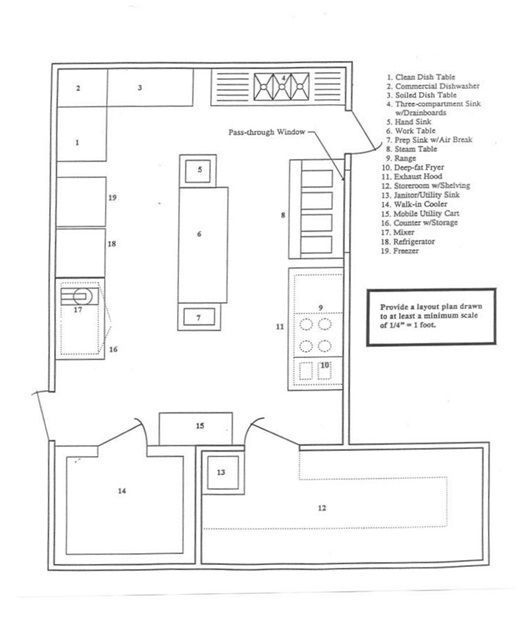 Years of use have shown her that it is much more convenient to place her near the refrigerator at a height just below the owner's shoulder.
Years of use have shown her that it is much more convenient to place her near the refrigerator at a height just below the owner's shoulder.
- Stove.
More and more often, when planning kitchen design, instead of full-size gas stoves, we choose hobs and independent ovens. You can find a lot of places for the hob, but where to put a fairly large oven? Like before, on the floor?
No! The ideal place for the oven would be the area at chest level. This way you won't have to bend over every time to see if the chicken is burning or to take out the baking sheet.
If you use the oven frequently, it is best to position it at chest height.In which area of the kitchen should the oven be located? Its place is in the cooking zone. You can place it, for example, in a column next to the hob.
IMPORTANT! If possible, plan a countertop area next to the oven. It will be the place for what you get out of it.
The minimum dimensions of this area must correspond to the pan.
- Dishwasher.
Based on the chain of actions “shook the rest of the food into the trash can under the sink and put the plate in the dishwasher”, you can understand that the sink and the dishwasher are inseparable.
Regardless of the layout of the kitchen, the dishwasher should be in line with the sink (the bin below it) so that its open door does not interfere with the removal of food residues into the bin.
It is good if there is a cabinet between the sink and the dishwasher. Its size is enough to comfortably stand between two open doors.
- Hood.
The standard installation location for this type of kitchen appliance will be the part of the wall above the stove. If the stove is electric, then the recommended distance between them is 60-65 cm, and if it is gas, then 75 cm. But this point is better to check with your own forehead. Are you hitting the hood?
- TV.
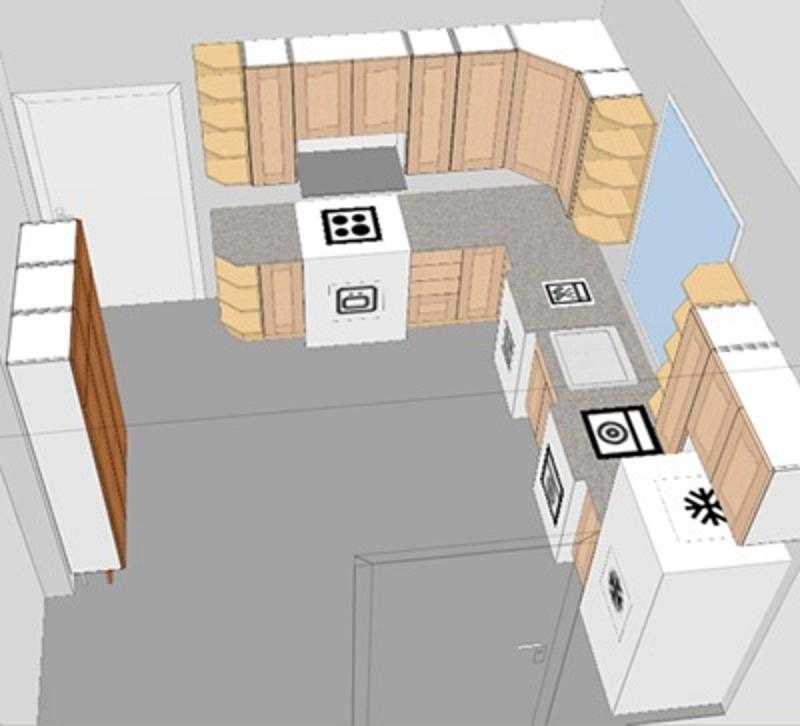
Yes, it can also be considered a kitchen appliance. You can find a lot of places to install it, but keep in mind that the hostess does not watch it during the cooking process, but listens. Therefore, focus on those sitting at the table.
How to position the sink and worktop in the kitchen?
The kitchen is mostly a place for cooking, its design and interior directly depends on our daily chores. We spend a lot of time here washing dishes and preparing food. How to arrange the countertop and sink so that it is convenient and the lack of space does not make you nervous?
- Worktop.
One of the key parameters of kitchen ergonomics is the height and length of the worktop. It is the place where you will stand for a long time. For the most convenient work on it, a height is suitable - below 15 cm from the bent elbow.
The minimum convenient size for a worktop is 100 cm.
What can be an additional workplace? As ideas, you can take a built-in dishwasher and washing machine, a work area on the windowsill, a drawer or a pull-out table.
IMPORTANT. The room will not be ergonomic without lighting. When planning the interior, do not forget to take care of lighting the working area of the kitchen and other places of your activity.
- Wash.
Perhaps thanks to the dishwasher, it is no longer such a significant place in your home. However, there are a number of rules that will always apply to kitchen sinks:
- There must be at least 60 cm between the sink and the stove.
- Do not place the sink in a corner.
- At 90%, the sink should be deep (18-25 cm) and the mixer should be tall. But consider your height, if the size of the sink makes you bend over it, then reduce it.
- The sink should be large enough to soak the tray.
How to choose a kitchen interior design based on the type of layout?
Now furniture factories have a huge number of opportunities to create a kitchen design that can satisfy any wishes, but the room and its technical characteristics can limit the customer's imagination.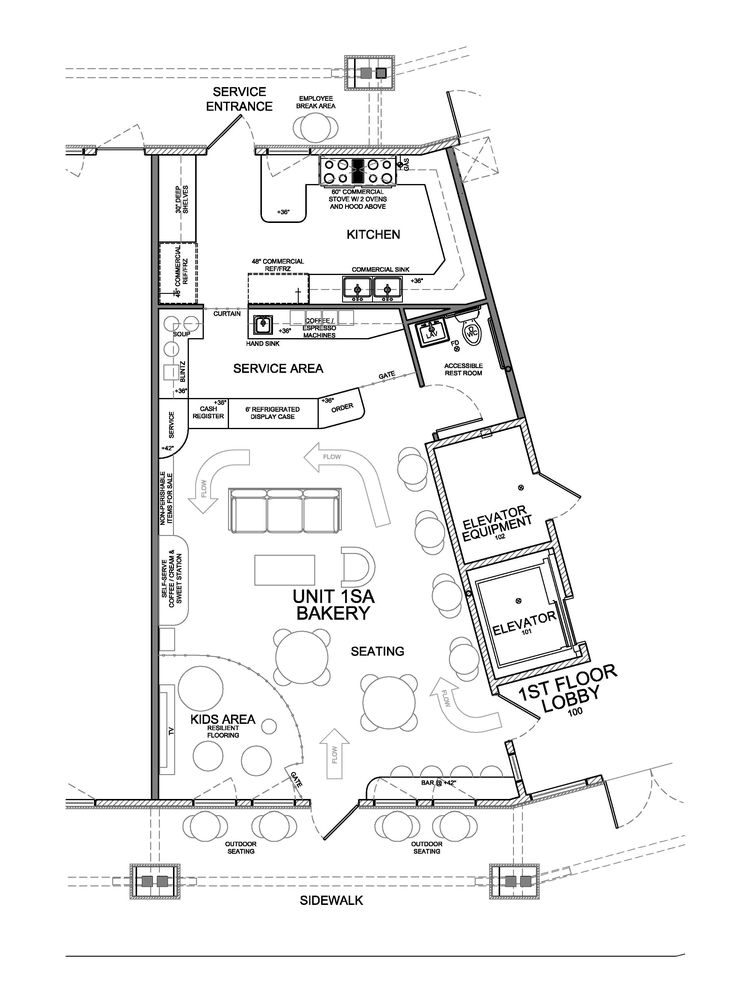 Which headset configuration to choose for a particular layout?
Which headset configuration to choose for a particular layout?
Square kitchen
The square layout is considered the most versatile. Ideas for the design of such a kitchen can be a million. Its dimensions do not affect the design of the furniture in any way. It will be possible to place furniture and appliances in such a room by all known methods:
- Single row (linear) type.
With this method, the place for the headset is one wall. To make it comfortable to use the kitchen, at least 2 m should be left between the set and the opposite wall.
- Two-row (parallel) type.
This type involves placing the set in the interior of the kitchen along two opposite walls, leaving at least 2 m of free space between them. Most often, the room for a parallel configuration of the headset looks like this - the entrance to the kitchen is in the center of the wall, and the window is opposite the entrance.
- L-shaped (angle) type.
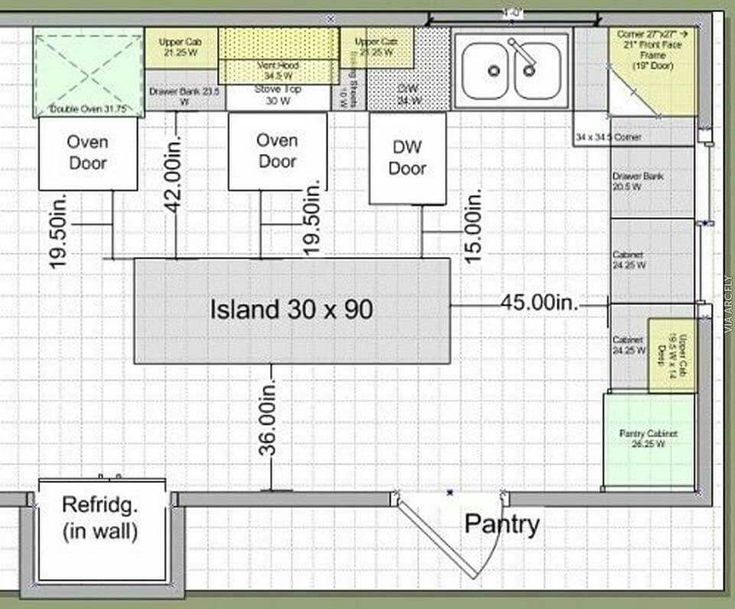
Suitable for any size room. When arranging furniture and appliances, 2 adjacent walls are used.
- U-type.
Here the size of the room matters. This type of configuration can be used in planning the design of kitchen spaces from 10 m2. There are a lot of places for a kitchen set and appliances - they are distributed along three walls.
- Island and peninsular type.
Does the layout of your apartment include a kitchen room from 20 m2? Feel free to choose this type of configuration, though keep in mind that the convenient width of the passage in the kitchen in two lines or a kitchen with an island is 110-120 cm. The island can become a place for storage, washing dishes, cooking, etc. The size of the island and its content is negotiated individually.
Narrow kitchen area
Apartments with an elongated and narrow kitchen layout can be found both in the old stock and in new buildings. In such cases, there are not many places for a kitchen set.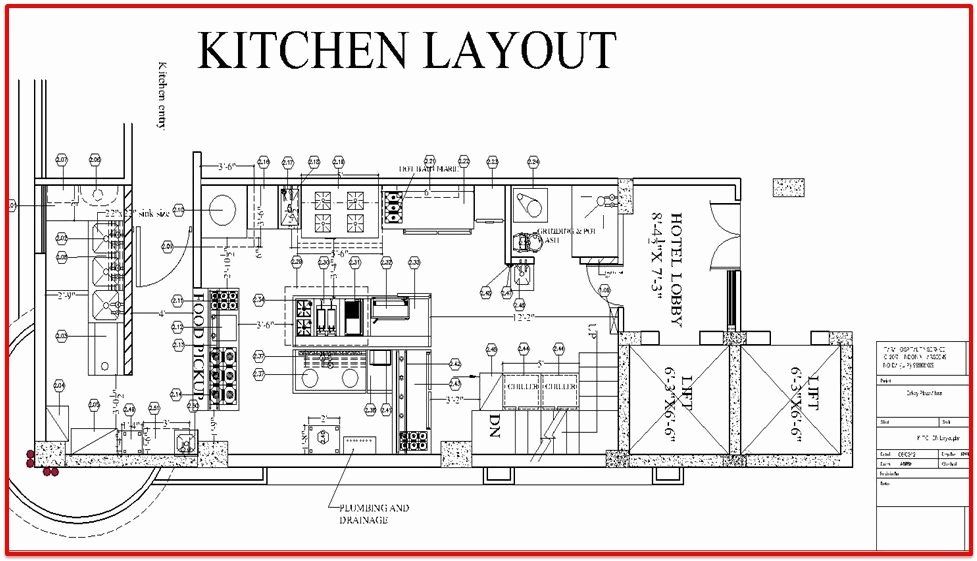 There is only one option - to place it along one wall (straight or linear configuration). The minimum width of a room for a kitchen is 160 cm, but its length can be any size.
There is only one option - to place it along one wall (straight or linear configuration). The minimum width of a room for a kitchen is 160 cm, but its length can be any size.
Small kitchen space
Small kitchen? No problem! Planning a small kitchen space is an interesting challenge for a designer. A bespoke kitchen will solve this problem countless times. The designer will design the required number of storage spaces.
There are many ideas for optimizing kitchen space - cabinets to the ceiling, the use of multifunctional appliances, a pull-out table, a window sill, etc. In the layout of an apartment with a small space for the kitchen, a linear and angular type of headset configuration is most often used.
A large room for a kitchen or a kitchen-living room
A large apartment and such a layout is a dream and room for imagination. There is enough space for arranging furniture in it, therefore, absolutely any type of headset configuration can be considered as an idea for designing a kitchen in a large room.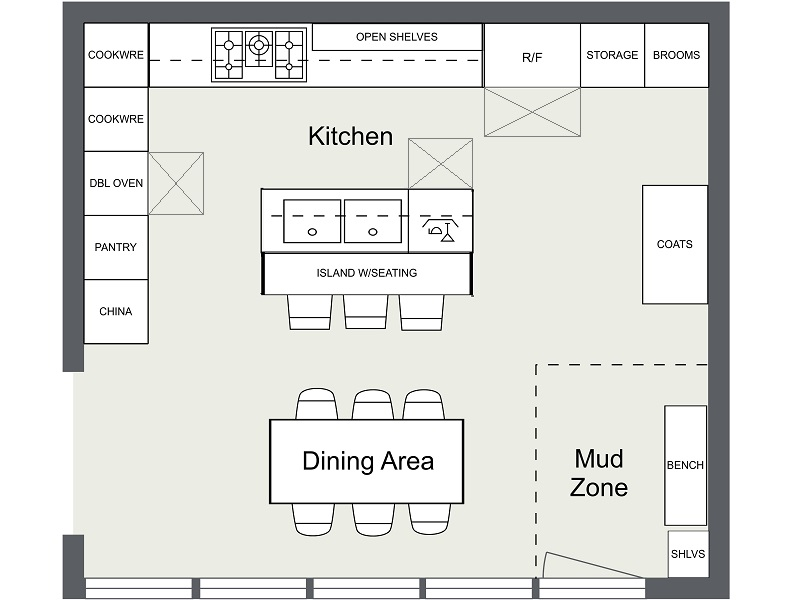
If the room is through (pass-through), then the best option would be parallel placement. True, the large size of the room can play a cruel joke - an illiterate layout of places of activity can lead to unnecessary unjustified movements during use.
Kitchen for a studio apartment
As a rule, the size of a kitchen in a studio apartment is not rich in square meters and there is not enough space for furniture. One of the best solutions for this type of layout would be a U-shaped or peninsular configuration. They will be able to make a functional kitchen even in the smallest area.
With this arrangement of 4 m2 furniture, you can not only fit all the necessary kitchen furniture and appliances, but also a compact dining area. Another advantage of such structures is zoning.
Also in a studio apartment, you can give preference to a linear and angular layout of the kitchen. When choosing a configuration, not only the layout of the room will play a role, but also the general design idea in the apartment.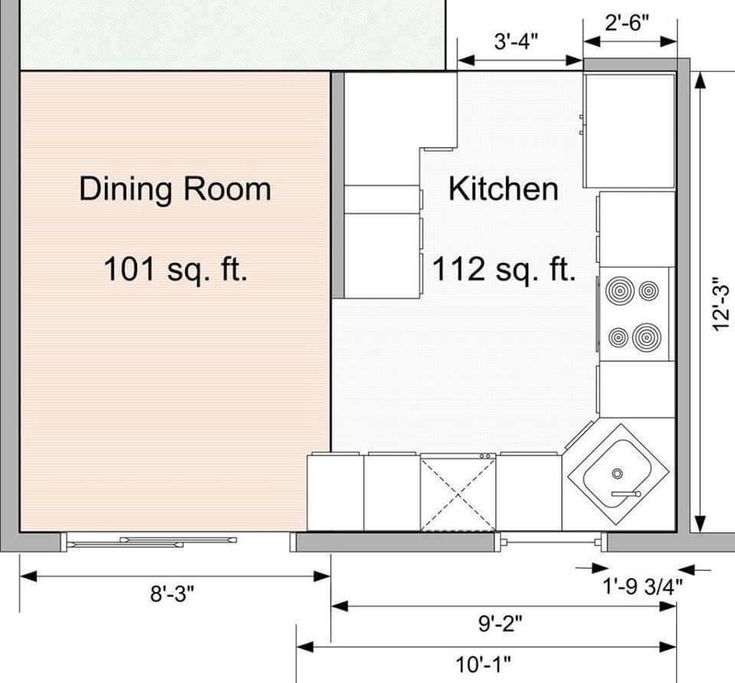
Irregular kitchen
The layout of the apartments can really surprise you. What if the kitchen should be in a room where not 4 corners are provided, but 3, 5 or even 6? Or if the layout has numerous window openings and protruding walls?
Rejoice, you have the opportunity to make such a kitchen, the interior of which you will be proud of, and the guests will sigh enthusiastically! A bespoke kitchen will help you with any type of layout.
What and where to store in the kitchen?
When choosing sets, you should pay attention not only to the layout and interior design ideas. The design of the kitchen, or rather its convenience, also depends on the storage places and their location. Think about how big the shelf should be for the largest pan?
The room can be divided into 3 zones horizontally and vertically:
- Near (central). Here you need to store everything that is used daily.
- Medium. On the edges from the central part, arrange things that are needed from time to time.
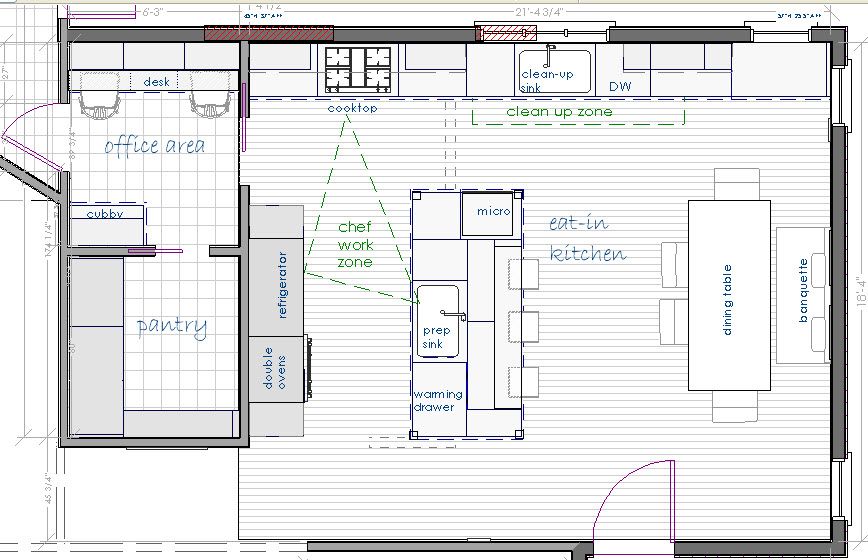
Learn more

